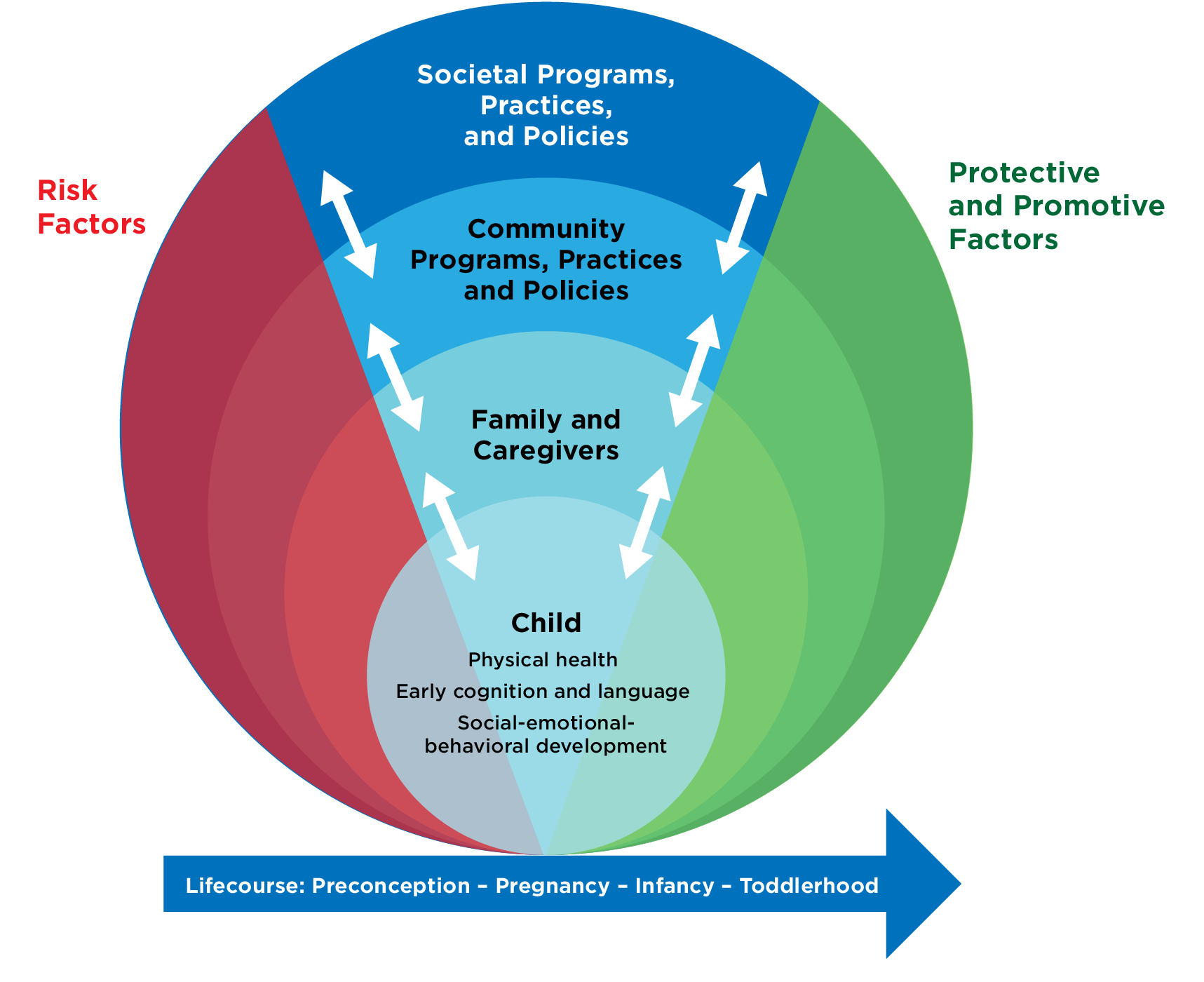About the project
The Measuring Up project works to identify promotive and protective factors, including family and community circumstances as well as policies and programs that help young children develop optimally and equitably. We also identify risk factors that can prevent optimal development in very young children. Measuring Up focuses on identifying these factors for the prenatal period (before birth) through age 2.

The overarching goal of the Measuring Up project is to help policymakers, researchers, and other individuals and organizations invested in early childhood development assess strengths and opportunities for improvement in key policies, programs, and practices that impact well-being in the prenatal, infant, and toddler stages of child development.
Key findings from our research
Our work began with exploring and understanding the infant-toddler well-being data landscape. We then developed and refined an approach to studying the impacts of various state-level policies on child well-being outcomes by starting with outcomes for which national and state-level data are readily available—namely, child maltreatment and child welfare system involvement. Next, we will launch another effort to apply this approach to understanding the impacts of various policies on outcomes related to developmental delays in very young children. Below we describe significant findings from each stage of our work.
Indicators of infant and toddler well-being are lacking.
SUMMARY
- Existing measures of infant and toddler well-being focus heavily on the child’s physical health, and little attention is given to their cognitive (i.e., brain) and social-emotional-behavioral health.
- Most indicators focus on contextual, or environmental, influences on a child’s development (for example, health care settings and family and caregiver environments) rather than on the actual outcomes (i.e., results) experienced by that child.
- Indicators that examine outcomes for individual children frequently focus on the absence of positive development (in other words, problems or delays in development) rather than the presence of positive development.
- Many existing indicators come from one of three data collection systems supported by the U.S. Department of Health and Human Services (HHS): the National Immunization Survey (NIS), the National Survey of Children’s Health (NSCH), and the National Vital Statistics System (NVSS).
Publication
Measuring Up Project Executive Summary and Call to Action (Darling & Ryberg, 2022)
Data on child well-being are not robust enough for thorough analysis and exploration.
SUMMARY
- In general, national data sources do not allow us to examine findings by important factors of child, family, or community diversity (e.g., race, ethnicity, household composition, economic well-being, etc.). In practice, this means that even high-quality data cannot tell us how outcomes may differ for children. This drawback prevents decision makers from understanding whether specific programs and policies benefit all groups of children.
- State-level implementation of key federal policies (e.g., the Earned Income Tax Credit, or EITC; and Temporary Assistance for Needy Families, or TANF) varies widely and data connecting implementation features to intended outcomes are scarce.
Publication
Measuring state-level infant and toddler well-being in the United States: Gaps in data lead to gaps in understanding (Ryberg et al, Child Indicators Research, 2022)
State-level implementation of select economic and family support policies have the potential to reduce maltreatment and child welfare system involvement among infants and toddlers.
SUMMARY
- States’ implementation of state child tax credits (CTCs) was associated with lower levels of neglect reports among Black and Hispanic children.
- The expansion of contraceptive access policies was also associated with reductions in maltreatment reports for all racial groups and in substantiation rates for Hispanic and White children.
- Less restrictive Supplemental Nutrition Assistance Program (SNAP) eligibility requirements were associated with lower maltreatment reports and victimizations for the overall population (although without significant effects when analyzed by race).
- We also found associations between minimum wage increases and lower neglect report and substantiation rates for White, Black, and Hispanic infants and toddlers.
Publications
State policy levers for reducing early childhood maltreatment: the importance of family planning and economic support policies (Abdi et al, 2023)
Identifying the Effectiveness of Policies That May Prevent Child Maltreatment Among Infants and Toddlers (Pina et al, Child Maltreatment, 2024)
Leveraging Economic and Health Policies to Prevent Infant & Toddler Maltreatment: A State Policy Toolkit
See the Project Accomplishments section below for more information.
Early intervention systems responsible for detecting and serving infants and toddlers with developmental delay are complex and under-resourced.
SUMMARY
We convened subject matter experts representing research, data, practitioner, policy, and family perspectives. All reported needing higher-quality data—including data connected across systems—as well as challenges around the fractured, multi-disciplinary workforce that supports infants and toddlers with developmental delay and their families. Specific expert insights included the following:
- States use different measures in early intervention screenings and have different thresholds for what is required to establish eligibility for services.
- Given these differences across states, state-level data on early intervention activities or outcomes cannot be reliably compared, leaving only national data sources for researchers to use.
- Families need better tools and more support from service providers to help them understand and enhance their child’s development.
- It is difficult for providers and policymakers to effectively govern and administer well-intentioned but often siloed programs and services (i.e., those that operate independently and tend not to share information).
- Policymakers need more information and better data so they can make informed decisions to support the efficacy and accessibility of early intervention.
- Long waitlists, high workforce turnover, and low pay all impact the efficacy of the early intervention workforce.
PUBLICATIONS
FORTHCOMING!
See the Project Accomplishments section below for more information.
Project accomplishments
Our work is conducted in phases: We first carefully examine policy and data landscapes; then conduct rigorous, original data analysis; then engage internal and external subject matter experts and policymakers; and finally publish our results and considerations for policymakers and other target audiences. To date, the project has made multiple novel contributions related to identifying and exploring risk factors and protective or promotive factors associated with important child development outcomes. These include:
- Creating a more nuanced conceptual model that articulates key dimensions of a child’s social ecology (see Figure 1)
- Developing partnerships with other organizations doing relevant work in this sphere (e.g., the Prenatal to Three Policy Impact Center and the Zero to Three State of Babies Yearbook team)
- Consulting with numerous experts on child development, data sources and their characteristics, and policy priorities
- Creating a prototype for rigorous multivariate analysis (i.e., a statistical way of measuring what does and does not work) comparing selected child outcomes with state-level policy contexts; this prototype serves as our blueprint for future work
Figure 1: Early Childhood Social-Ecological Contexts of the Child

Source: Measuring Up Project team, 2022. For more information and how to interpret this model, see source notes.
Figure Notes
Our work on developmental delay
In 2023, we began a new study within the project—Measuring Up2: Examining Policy Factors Related to Prevalence of Infant-Toddler Development Delay. This work examines risk and protective factors associated with developmental delay, as well as specific policies, programs, and practices that exist to prevent or address developmental delay. Specifically, the project team is exploring state variability in referrals, screenings, and service uptake among children experiencing developmental delay, hoping to discover how to promote maximum positive development among children who do not meet developmental milestones. As part of this work, we aim to identify systemic or programmatic achievements that may mitigate racial and ethnic inequities related to identifying and serving all children experiencing developmental delay. A summary of baseline work, setting the stage for future phases of research, can be found here.
We plan to use reliable national data—such as the National Survey of Children’s Health (NSCH) household data and IDEA Part C Section 618 service provision data—to examine incidence of developmental delay in infants and toddlers and whether service access and provision is proportionate across states. We also plan to explore the potential influence of insurance payer policy on screening, referrals, and service uptake.
Our ultimate goal is to identify states that have successfully made connections with or between policies, programs, or practices—with evidence of effects on the prevalence of positive developmental outcomes for very young children—and amplify their strategies for others to replicate.
Measuring Up Collaborative members and funders
Child Trends partners on this work with several other organizations, including the Marcus Autism Center (MAC) and the National Center on Birth Defects and Developmental Disabilities (NCBDDD) at the Centers for Disease Control and Prevention (CDC), with periodic engagement from the Georgia Department of Public Health (GA-DPH) and the U.S. Health Resources and Services Administration (HRSA). This group of partners is referred to as the Measuring Up Collaborative (or “the Collaborative”).

© Copyright 2025 ChildTrendsPrivacy Statement
Newsletter SignupLinkedInYouTubeBlueskyInstagram